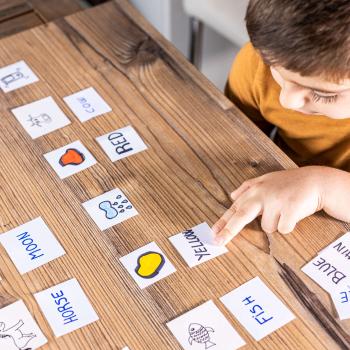Interaction and adventure draws high school and elementary school students together as they analyze stories about the Lewis and Clark expedition.

Exploring Cross-Age Tutoring Activities With Lewis and Clark

Grades
|
Magazine Redux: An Exercise in Critical Literacy
9 - 12
Lesson Plan
|
Standard Lesson
Paper and pixels get compared in this lesson in which students compare both printed and online versions of a magazine.

Grades
|
Critical Reading: Two Stories, Two Authors, Same Plot?
9 - 12
Lesson Plan
|
Standard Lesson
Students make predictions about the stories and analyze story elements, compare and contrast the different stories, distinguish between fact and opinion, and draw conclusions supported by evidence from their readings.

Grades
|
Everyone Loves a Mystery: A Genre Study
6 - 8
Lesson Plan
|
Unit
Students track the elements of mystery stories through Directed Learning-Thinking Activities, story maps, and puzzles. Then they offer clues for other readers as they plan and write original mystery stories.

Grades
|
Word Sorts for Beginning and Struggling Readers
K - 2
Lesson Plan
|
Standard Lesson
Students are introduced to short-vowel word families and learn to sort words alone and with a partner using the Word Family Sort activity.

Grades
|
Analyzing the Purpose and Meaning of Political Cartoons
9 - 12
Lesson Plan
|
Standard Lesson
It is important for students to know how to evaluate messages conveyed by the news media. Exploration of the artistic techniques used in political cartoons leads to critical questioning.

Grades
|
Mind Pictures: Strategies That Enhance Mental Imagery While Reading
6 - 8
Lesson Plan
|
Standard Lesson
Students create mental images while reading using a three-pronged approach: developing schemata and visual awareness; Watch-Read-Watch-Read (W-R-W-R), using video clips; and a strategy similar to the think-aloud approach.

Grades
|
What Did They Say? Dialect in The Color Purple
9 - 12
Lesson Plan
Y'all set down a spell and learn ‘bout dialects!" In other words, your students will use The Color Purple to explore dialect and how it reveals information about the characters.

Grades
|
Teaching Point of View With Two Bad Ants
3 - 5
Lesson Plan
|
Standard Lesson
Students will be crawling all over this assignment when they use illustrations and text to learn about life from a bug's point of view.

Grades
|
Identifying and Classifying Verbs in Context
3 - 5
Lesson Plan
|
Minilesson
The interactive read-aloud in this lesson helps students to identify and classify the three verb typesaction, state-of-being or linking, and helping verbs.

Grades
|
Peer Edit With Perfection: Effective Strategies
3 - 5
Lesson Plan
|
Standard Lesson
Students take a fresh look at the revision process and help one another polish their written work through a peer-editing strategy that is simple, systematic, and constructive.

Grades
|
Identifying and Understanding the Fallacies Used in Advertising
9 - 12
Lesson Plan
|
Standard Lesson
Students examine the fallacies that surround them every day, deconstruct fallacious images and messages in advertisements, and demonstrate their understanding of the fallacies through multimedia presentations.

Grades
|
Diagram It! Identifying, Comparing, and Writing About Nonfiction Texts
K - 2
Lesson Plan
|
Unit
Students compare the traits fact and fiction by using a Venn diagram to compare fiction and nonfiction books about Native Americans.

Grades
|
Using Historical Fiction to Learn About the Civil War
3 - 5
Lesson Plan
|
Standard Lesson
Students in grades 4 and 5 discuss inferential comprehension and visualization as they use a think-aloud questioning strategy to develop a deeper understanding of a historical novel.

Grades
|
Fact or Fiction: Learning About Worms Using Diary of a Worm
K - 2
Lesson Plan
|
Standard Lesson
Students often believe that fiction writers make everything up, seldom realizing how research worms its way into entertaining writing. In this lesson, students read Diary of a Worm to find out how fact merges with fiction.

Grades
|
Writing Free Verse in the "Voice" of Cesar Chavez
6 - 8
Lesson Plan
|
Standard Lesson
Poetry and politics combine in this lesson where students write a free verse poem in the voice of Cesar Chavez.

Grades
|
Going on a Shape Hunt: Integrating Math and Literacy
K - 2
Lesson Plan
|
Standard Lesson
Students participate in a scavenger hunt for shapes; reading, writing, and discussion of shapes encourage literacy and math skills.

Grades
|
Word Maps: Developing Critical and Analytical Thinking About Literary Characters
9 - 12
Lesson Plan
|
Standard Lesson
Students read "After Twenty Years" by O. Henry, use a word map to identify characters' qualities or traits, discuss the characters' feelings and actions, and reflect upon these in journals.

Grades
|
Telling a Story About Me: Young Children Write Autobiographies
K - 2
Lesson Plan
|
Unit
Students tell their life stories in this lesson about autobiographies based on family photographs.

Grades
|
Readers Theatre With Jan Brett
1 - 2
Lesson Plan
|
Standard Lesson
Students in grades 1-2 use Jan Brett's Hedgie's Surprise for a Readers Theatre experience.